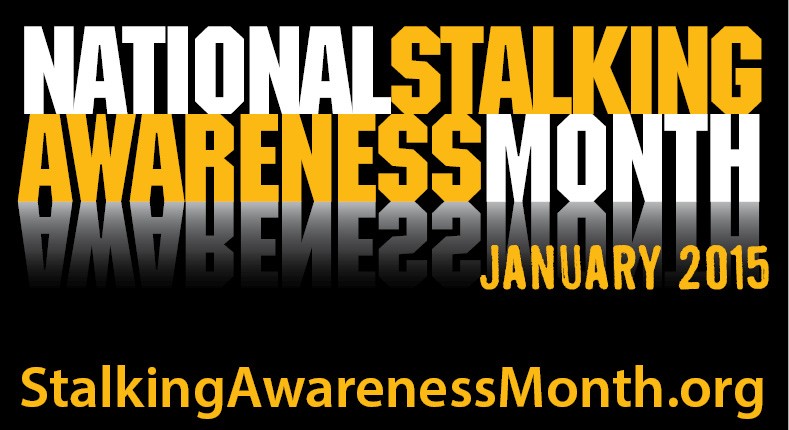The Azusa PD Blog
January Is Stalking Awareness Month
This month is National Stalking Awareness Month. Through education and support, we can all help victims of this horrible crime.
From the StalkingAwarenessMonth.org website, here are some facts you may not know about stalking:
- 6.6 Million people are stalked in one year in the United States
- 1 in 6 Women and 1 in 19 men have experienced stalking
- 66% of victims are female and 41% are male
- 46% of victims experience unwanted contact with their stalkers at least once a week
- 2/3 of stalkers pursue their victims at least once a week
- Weapons are used to harm or threaten victims in 1 out of 5 cases
What Is Stalking?
Stalking is a crime that doesn't seem to end, because it continues over, and over. The repeated conduct or actions of a person that instills fear in another person is stalking.
Stalker Behavior
Continual repetition of criminal and non-criminal acts constitutes stalking. Some common behaviors are:
- Assaulting the victim, whether sexual or non-sexual in nature
- Violating protective orders
- Vandalizing the victim's property
- Burglarizing the victim's residence
- Stealing items from the victim
- Threatening the victim in any manner
- Harming the victim's pets, and even family members
Stalkers may send the victim gifts, cards, letters or notes, and he or she may even personally deliver them or leave them on the doorstep, at work or on vehicles. They might follow the victim and wait for the victim to exit their residence, work or an event or store. Stalkers might even send pictures or videos of the victim, when they didn't know the stalker was around.
Obviously stalkers use modern technology, such as social media and cell phones. Check out a previous article we published, "When Your Ex Threatens Your Peace Both Online And Off..." for information about online safety. As for stalkers using GPS devices, California Penal Code Section 637.7 covers the issues regarding electronic stalking.
What's The Law Section For Stalking
California Penal Code Section 646.9 is the appropriate section for this crime, which states:
(a) Any person who willfully, maliciously, and repeatedly follows or willfully and maliciously harasses another person and who makes a credible threat with the intent to place that person in reasonable fear for his or her safety, or the safety of his or her immediate family is guilty of the crime of stalking, punishable by imprisonment in a county jail for not more than one year, or by a fine of not more than one thousand dollars ($1,000), or by both that fine and imprisonment, or by imprisonment in the state prison.
What To Do If You Are Being Stalked
Here is a great video produced by thesafetyfactor.ca website and Jennifer Vallance.
If you are the victim of stalking, it is imperative that you notify law enforcement immediately. We need to start an investigation, so we can put an end to this crime and bring some peace back to your life. Here are some tips to remember:
General Safety:
- If possible, have a phone nearby at all times, preferably one to which the stalker has never had access. Memorize emergency numbers, and make sure that 911 and helpful family or friends are on speed dial.
- Treat all threats, direct and indirect, as legitimate and inform law enforcement immediately.
- Vary routines, including changing routes to work, school, the grocery store, and other places regularly frequented. Limit time spent alone and try to shop at different stores and visit different bank branches.
- When out of the house or work environment, try not to travel alone and try to stay in public areas.
- Get a new, unlisted phone number. Leave the old number active and connected to an answering machine or voicemail. Have a friend, advocate, or law enforcement screen the calls, and save any messages from the stalker. These messages, particularly those that are explicitly abusive or threatening, can be critical evidence for law enforcement to build a stalking case against the offender.
- Do not interact with the person stalking or harassing you. Responding to stalker's actions may reinforce their behavior.
- Consider obtaining a protective order against the stalker. Some states offer stalking protective orders and other victims may be eligible for protective orders under their state's domestic violence statutes.
- Trust your instincts. If you're somewhere that doesn't feel safe, either find ways to make it safer, or leave.
If you are in imminent danger, locate a safe place. Consider going to:
- The closest police station
- Residences of family or friends (locations unknown to the perpetrators)
- Place of worship
- Public areas (some stalkers may be less inclined toward violence or creating a disturbance in public places).
Safety at home:
- Identify escape routes out of your house. Teach them to your children.
- Install solid core doors with dead bolts. If all keys cannot be accounted for, change the locks and secure the spare keys. Fix any broken windows or doors.
- Have a code word you use with your children that tells them when they need to leave. Inform neighbors and, if residing in an apartment, any on-site managers about the situation, providing them with a photo or description of the stalker and any vehicles they may drive if known. Ask your neighbors to call the police if they see the stalker at your house. Agree on a signal you will use when you need them to call the police.
- Pack a bag with important items you'd need if you had to leave quickly. Put the bag in a safe place, or give it to a friend or relative you trust.
- Consider putting together a "stalking sack" that includes the stalking log, a camera, information about the offender, etc. Click here for more information on Stalking Sacks
Safety at work and school:
- Give a picture of the stalker to security and friends at work and school.
- Tell your supervisors. They have a responsibility to keep you safe at work.
- Ask a security guard to walk you to your car or to the bus.
- If the stalker contacts you, save any voicemails, text messages, and e-mails.
- Give the school or daycare center a copy of your protective order. Tell them not to release your children to anyone without talking to you first.
- Make sure your children know to tell a teacher or administrator at school if they see the stalker.
- Make sure that the school and work know not to give your address or phone number to anyone.
- Keep a copy of your protective order at work.
Remember, get law enforcement involved as quickly as possible. Together, we can get you through this!
We credit the StalkingAwarenessMonth.org website for much of the content used in this article.
"Professional Service To A Proud Community"
Azusa Police Department | 725 N. Alameda Avenue | Azusa, CA 91702
Terms of Service | Privacy Policy | Social Media Policy | Site Map


